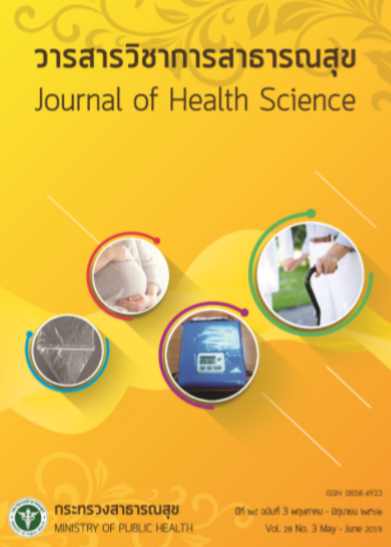Working Age Wellness Center Model Development
Keywords:
wellness center, working age, health behaviorAbstract
The objectives of this research were to develop working model for working age wellness center (WWC), study results of the operation WWC, assess satisfaction on the services, and identify problems in the operation. The study samples consisted of 62 workers at WWC of 7 target hospitals, 214 persons receiving services for modifying health behavior within the hospitals, and 191 persond outside the hospitals. The tools used in the study were WWC operation model, questionnaire for receiving services in the WWC, performance record form, and guidelines for group discussion. Quantitative data were analyzed by descriptive statistics and paired t-test; and qualitative data was analyzed by content analysis. It was found that the WWC model had 1 manager; and the operators were staff from various agencies performing integrated work together. The place were either located somewhere or established as a particular center. Equipment for WWC consisted of basic tools such as the screening forms for various risks, weight scale, the temple height, waist circumference, blood pressure monitor, body fitness test. Services were provided both inside and outside the hospitals for healthy groups, risk groups and chronic non-communicable diseases or others illnesses. Such services included health screening, health check-up, evaluating physical fitness, health counseling, modifying health behavior, exercise practice, smoking cessation, alcohol abstinence services, vaccination, oral health examination, cancer detection, and screening for occupational diseases. After the services, the recipients were advised to take care of themselves at home. It was found that, the health behaviors of the recipients were significantly better than before receiving services (p<0.001). Their body weight, waist line, smoking quit, physical fitness in lung capacity, and strength better than before receiving services (p<0.05). Most service recipients in and outside the hospitals had expressed high level of satisfaction on the services (79.9% and 80.6%, respectively). The problems identified in the operation of WWC included limited task integration, lack of staff and tools, unavailability of service sets, and the difficulty in the disbursement of services according to various entitlements. Based on the study results, it could be concluded that the operation model for WWC had good effectiveness, high service recipients’ satisfaction, and operational feasibility. Thus, the model should be widely applied and operated in other health service facilities.
Downloads
Downloads
Published
How to Cite
Issue
Section
License
Copyright (c) 2019 Journal of Health Science - วารสารวิชาการสาธารณสุข

This work is licensed under a Creative Commons Attribution-NonCommercial-NoDerivatives 4.0 International License.







